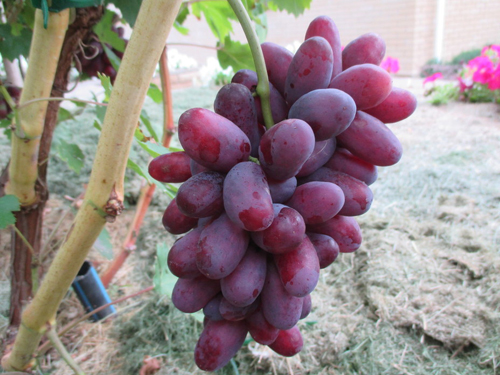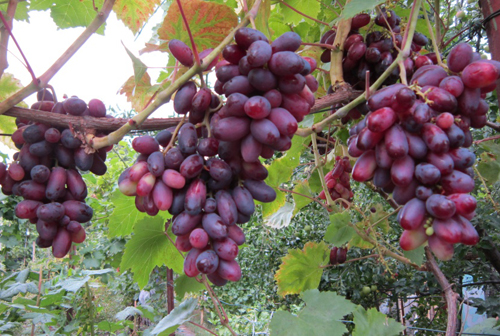Grape variety Zest
Table grape variety Zest is a very interesting result of the work of Crimean breeders from the Scientific Research Institute of Viticulture and Winemaking "Magarach". It was bred by crossing the old Turkish variety Chaush with the famous Cardinal.
Having been born, the new hybrid received from its parents excellent gastronomic and aesthetic qualities of the fruit, however, as a purebred representative of the European-Asian cultivated species Vitis vinifera, it also inherited susceptibility to fungal diseases and a certain delicacy in cultivation. In addition, the type of flowering in plants turned out to be functionally female, which requires planting nearby bisexual pollinating varieties that bloom at the same time.

All these contradictions did not allow Izuminka to pass the state variety testing and be admitted to industrial cultivation, however, it gained sufficient popularity among amateur winegrowers. For the stunning appearance of ripe bunches and the wonderful taste of berries, enthusiasts are ready to forgive her for all the existing economic shortcomings. Carefully caring for the grape bushes, they get excellent harvests of our heroine, who for many of them has become one of the favorites in the vineyard.
Agrobiological characteristics
The plants are extremely vigorous. The crown of a young shoot is shiny, without pubescence, greenish-bronze in color. The color of young leaves is similar. Full leaves grow large, rounded, usually five-lobed, with a weak or medium dissection between the lobes. The leaf surface is smooth, dark green, with lighter veins, often with noticeable anthocyanin pigmentation at the base. The profile of the leaf blade is flat or medium-wavy. Upper lateral notches of moderate or shallow depth, mostly open, in the form of a reentrant angle or in the form of a lyre, sometimes closed, with almost no gap. The lower notches are small, just like the upper ones, they can be V-shaped, or barely outlined. The petiolate notch is almost always open, but different in shape: vaulted, lancet, or lyre-shaped. Petioles are long and graceful, reddish in color. The teeth along the perimeter of grape leaves differ significantly from each other in size, but mostly have the form of triangles with slightly curved edges, bases of medium width and slightly blunt tops. The flowers of the variety are functionally feminine, which makes it impossible to pollinate them with their own pollen. This fact can cause pea berries or the formation of insufficiently fulfilled, overly loose clusters, in years with unfavorable weather conditions during the flowering period. However, in most cases, in the presence of well-chosen pollinators, problems with fertilization of the Raisin can be avoided. Ripening of the vine is going very well and by winter it has time to be completed in full. The color of the one-year growth then changes to brown.

The size of the bunches in this hybrid grape form is not outstanding. The average mask of mature brushes ranges from 450-500 grams. Their shape is conical or cylindro-conical, the structure is moderate in density. The combs are of medium length, herbaceous, but strong, greenish-red in color. Berries are the main decoration of the variety. They are oblong and very large, reaching 33−35 mm in length and 16−18 mm in diameter. Each grape weighs 8-12 grams, and a rich dark pink color complements their stunning appearance. The surface of the berries is covered with an easily washable layer of a light-colored protective wax coating. Due to the not too dense arrangement in the bunch, the grapes do not deform, do not crumple or damage each other. Their pulp is dense, fleshy, very harmonious in taste, but at the same time has a neutral aroma without bright memorable shades.Juice squeezed from ripe fruits of Zest contains about 16-18 g / 100 ml of sugars and 4-5 g / l of titratable acids. The skins of grapes do not create problems when chewing them, and the seeds, 2-3 per berry, are not very noticeable in a large volume of pulp, and therefore do not have a negative effect on the general taste characteristics. Grape tasting scores are above average, ranging from 8.1 to 8.4 points.
The main use of this variety is its fresh consumption. The bunches and berries have a very appetizing and attractive appearance, in connection with which the variety could be of interest to farmers, since in terms of its marketability parameters it can without any doubt be attributed to the market varieties, the harvest of which is in constant and high demand among buyers. The very early ripening period of the bunches also testifies in its favor, due to which they can appear on the shelves in the middle of summer, when prices for grapes are kept at a high level. In addition, the hybrid is also distinguished by good transportability, and its fruits do not lose their high qualities even after overcoming considerable distances.

However, not every commercial grower runs the risk of being associated with a rather capricious variety. Therefore, the main volumes of Raisin are obtained in personal households, where, in addition to direct consumption, they are widely used as a raw material for home canning. As a result, compotes, preserves, jams and marinades, excellent in taste and color, are harvested for the winter, which, in a gloomy winter, vividly remind winegrowers and their families of the colors of summer, while helping to cope with the lack of vitamins at this time of the year.
Despite its southern origin, the growing season for this hybrid form is very short. From the moment the buds open in the spring to the onset of the removable ripeness of the grapes, no more than 100-110 days pass. At home - in the Crimea, the hybrid can be cut off in late July - early August when the accumulation of the sum of active temperatures of only 2200-2300 ° C. Such a modest need for warmth allows our heroine to feel quite comfortable not only in traditional wine-growing regions, but also much further north - in the middle zone of our country. The biggest problem in this case is the low frost resistance of the bushes, not exceeding -18 ° C. In this regard, the variety is widely cultivated with shelter for the winter, and in regions of high frost risk, insulation should be especially careful.
The productivity of Raisin does not shine with stability and outstanding performance for a variety of reasons, ranging from possible problems with pollination of inflorescences or damage to fruit buds in winter, ending with a modest fruiting coefficient in the range of 0.9-1.1 and a relatively small size of bunches. At the same time, a significant part of winegrowers, with their work and competent approach, still manage to achieve a decent result, getting up to 15 kg of grapes from a bush. The hybrid is not prone to overloads, the main rationing occurs during spring pruning.
Ripe bunches can be left hanging on the vine for a long time without any special worries. The berries of our heroine have a remarkable property not to crack even with a sharp change in soil moisture in the event of rainy weather. The grapes ripening at the very peak of the summer heat can only be threatened with moisture loss in the absence of watering the plants, as a result of which the Zest can begin to justify its name by its appearance. The grapes are almost not damaged by wasps, which is also a very valuable indicator for many owners.
Agrotechnical features
The variety does not have any special requirements for planting conditions, however, experienced growers recommend placing it on gentle slopes of warm exposures, where overwintering conditions are considered more favorable compared to other relief options. The bushes are formed according to covering non-standard schemes in the form of a multi-arm fan or an oblique cordon. The plants that have entered fruiting are subjected to long pruning, leaving 10-12 eyes on the fruit arrows. The total load is given in the range of 40-45 buds per bush.It is imperative to carry out debris after the beginning of the growing season to remove weak and sterile shoots. The variety needs full protection against fungal diseases, carried out by repeated spraying with contact and systemic fungicides against the main pathogens of grapes.








